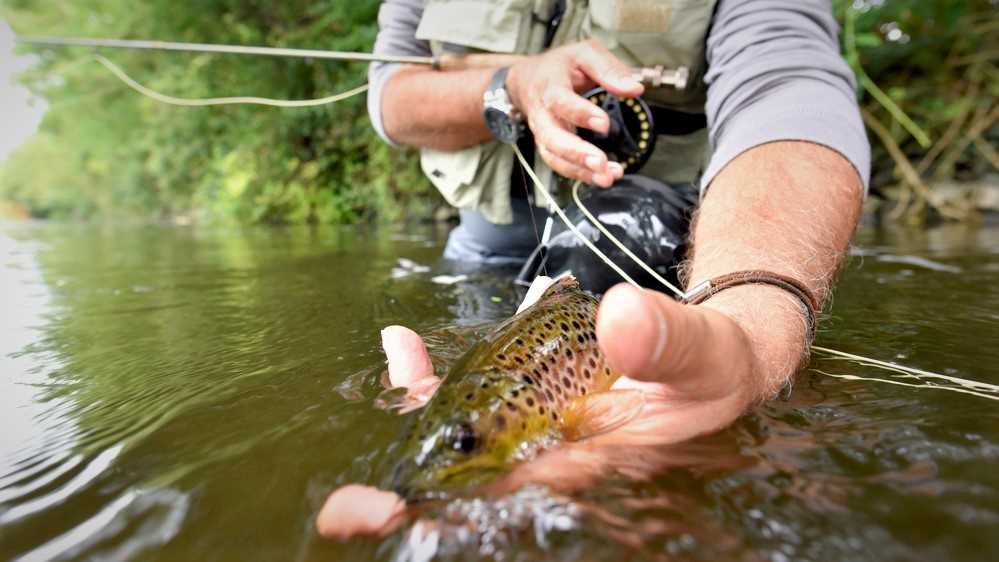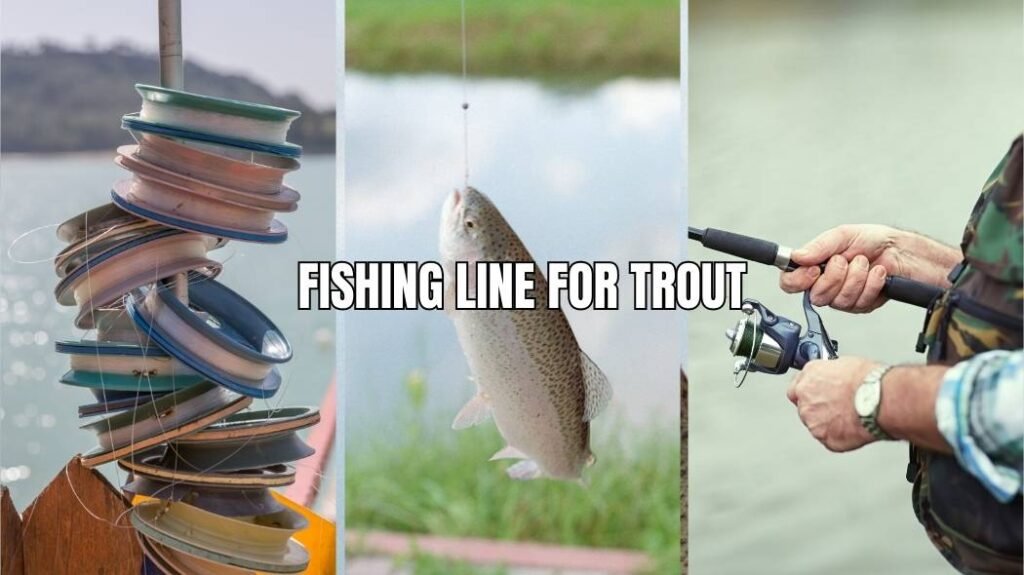River Fishing for Trout: Ultimate Guide
The sight of a rainbow trout rising to devour a dry fly on the surface of a winding river is enough to get any angler’s adrenaline pumping. I live for that exhilarating moment when the line suddenly pulls tight and my rod bends as I set the hook into a fighting fish.
River fishing for trout provides a thrilling experience full of challenges and rewards. Read on as I detail everything you need to know about pursuing trout in Hawaii’s bountiful waterways.
Key Takeaways
- Trout feeding patterns are influenced by seasonal changes in water temperature and flow.
- Identifying strategic spots is crucial for successful trout fishing.
- Mastering different casting techniques is important for river fishing for trout.
- Live baits can be effective in attracting and catching trout.
Trout Behavior and Habitats

Trout thrive in the cool, clear waters of Hawaiian streams. They congregate in specific habitats that meet their needs for shelter, food sources, and oxygen flow. As an angler, identifying these micro-ecosystems is key to locating where trout feed and rest.
The fish hunker down behind large rocks, logs, and undercut banks that provide refuge from the current. These structural hides give ambush points for attacking drifting prey.
Trout also gravitate towards riffles, where choppy water tumbles over the rocky stream bed. Here they find plentiful aquatic insects that get dislodged.
Yet trout can’t spend all day fighting swift whitewater. That’s why they regularly return to rest in deeper pools featuring downed trees, overhanging vegetation, and submerged structure.
Understanding trout habits allow you to pinpoint productive holding spots!
As for specific species, rainbow trout particularly favor clear streams with a gravel bottom and abundance of riffles oxygenating the water. Brown trout tend to inhabit somewhat slower rivers featuring more cover and deeper pools. And brook trout thrive in small, cold tributaries with dense overhead vegetation providing shade. Make sure to equip yourself for the unique conditions where each trout type resides.
Equipment Needed for Trout Fishing

When gearing up for a river trout mission, your rod and reel choice is paramount. You need a setup suitable for making accurate casts in tight surroundings, while still having the backbone to handle feisty fish.
For fly fishing, I recommend a 9ft, 5-wt rod with a smooth drag reel loaded with weight forward floating line. This versatile combo excels for dry flies and lightweight nymphs. When drifting chunky streamers or indicators, step up to a 6-wt rod.
Bait fishermen should opt for a 7ft ultra-light or light spinning rod rated for 4-10lb test. Pair it with a high-quality reel packed with 6lb monofilament or braided line. This allows firing casts into tight pockets and detecting subtle bites. Make sure to pack #6-10 baitholder hooks, split shot weights, bobbers, and other terminal tackle.
With the proper outfit, you’ll be equipped to place your offerings throughout prime trout terrain. Just don’t forget waders, polarized glasses, nets, stringers, and other fishing essentials!
Techniques for River Fishing: Mastering the Tactics

While trout thrive in streams, catching them there requires perfecting key angling methods. The overhead cast serves as the fundamental technique for fly fishing. It utilizes arm motion and rod tip movement to carry line high over the water, before presenting the fly delicately upstream of a drifting fish. For reaching tight spots under brush, the roll cast relies totally on arm movement to flip the lure sidearm across the water.
Bait chuckers also need to pinpoint their offerings. I rely on a sidearm pendulum swing to zip my rig under overhanging branches where trout wait to ambush prey. This underhand casting method takes practice, but allows accessing prime holding lies other anglers can’t reach.
Wading into a promising run and using high-stick nymphing is another deadly approach. Here you work lightweight nymphs just off the bottom, under an indicator. The setup lets you thoroughly work every inch of a run. Just be sure to limit wading in spawning areas during closed seasons.
Baiting and Lures
What the trout want to eat changes day to day and hour to hour, so match your offering to the trout’s appetite.
Here are some tips for effectively using live bait for trout fishing:
- Minnows: Perfect for larger trout, mimic their swimming with your bait presentation techniques.
- Worms: An all-around favorite, use a natural drift in the current for a convincing lure.
- Fish Eggs: Especially potent in spawning seasons, scented baits for trout can be a game-changer.
Live bait and artificials each account for their share of trout caught in rivers. Savvy anglers harness a variety of offerings tailored to particular scenarios. Is the water high and off-color from recent rains? Try floating a nightcrawler or minnow under a bobber in a slack pool. If clarity clears and fish start looking up, it’s time to break out the fly rod and start tossing dry flies.
Imitator offerings like Rapalas and Rebel minnow plugs come into play when trout key on baitfish. Nothing triggers savage strikes like ripping in-line spinners and spoons when you locate actively feeding fish during hatch events. Carry a diverse range of lures covering all bases.
Catch and Release: Ensuring Sustainable Fisheries
| Do’s for Trout Release | Don’ts for Trout Release |
|---|---|
| Wet your hands before handling | Hold trout out of water for long periods |
| Use barbless hooks for easy removal | Squeeze or touch the gills |
| Gently return trout to water | Toss or drop the trout back in |
As devoted trout anglers, we must utilize catch and release practices that ensure healthy fish populations for generations to come. This starts by limiting our take and avoiding high mortality techniques like bait fishing. Barbless hooks allow easy release with minimal injury or handling.
I like to keep trout in the water when removing hooks. If a fish needs to be netted, use soft knotless meshes. Limit air exposure to seconds, not minutes. If a trout is hooked deep, simply snip the line close rather than ripping it out. Photograph epic catches quickly before letting them swim away to fight another day.
Responsible catch and release fisheries policies have brought native species like cutthroat trout back from the brink in Hawaii. With conscientious stewardship, our rivers can thrive as world-class trout fisheries.
Endless Trout Adventures Awaits
As you can see, river trout fishing offers endless challenges, excitement and pristine wild places to explore. Now that you know the basics, it’s time to assemble your gear and hit Hawaii’s bountiful trout streams. Carefully work the heads and tails of pools, the soft seams behind boulders and regular casts across promising riffles. Be ready for subtle taps, lightning grabs and blistering runs of every sort.
Frequently Asked Questions
What are the best live baits to use when river fishing for trout?
Some top live bait choices are nightcrawlers, minnows, salmon eggs, and grasshoppers. Make sure to hook baits like ‘crawlers and minnows through the nose to keep them lively and natural looking as they swim.
What pound test line works best for trout fishing?
4-8 lb test monofilament or fluorocarbon line provides a good balance of strength, sensitivity and invisibility for trout fishing. Some anglers spool up with 2-4 lb braided line and attach a fluorocarbon leader.
How do you properly set the hook when trout fishing?
It’s important to strip strike or pull back firmly when you feel a bite or see your line/indicator moving unnaturally. Unlike bass, trout have bony mouths that don’t grip hooks well, so solid hook sets are key to higher catch rates.
Where are the best spots to catch trout in rivers and streams?
Target downed trees, boulders, undercut banks and bubble lines that indicate submerged structure. Trout orient facing into the current behind obstacles that break the flow while allowing for ambushes. Outside bends and pool tailouts also hold feisty fish.
What regulations apply to trout fishing in Hawaii?
Several Hawaiian rivers have special regs, including selective and fly-fishing only sections. Most impose maximum size limits to protect spawning fish. Know your area’s specific limits and whether single vs triple hook lures are permitted. Catch-and-release fishing helps conserve fragile trout fisheries.

